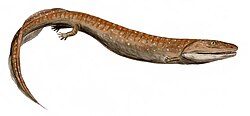| Elginerpetontidae Temporal range: | |
|---|---|
 | |
| Life restoration of Elginerpeton pancheni | |
| Scientific classification | |
| Domain: | Eukaryota |
| Kingdom: | Animalia |
| Phylum: | Chordata |
| Clade: | Sarcopterygii |
| Clade: | Tetrapodomorpha |
| Clade: | Stegocephali |
| Family: | † Elginerpetontidae Ahlberg, 1995 |
| Subgroups | |
Elginerpetontidae is an extinct family of basal stegocephalian tetrapodomorphs which lived in Europe during the Frasnian stage of the Late Devonian epoch. It contains the genera Elginerpeton , Obruchevichthys and Webererpeton . [1] [2]





